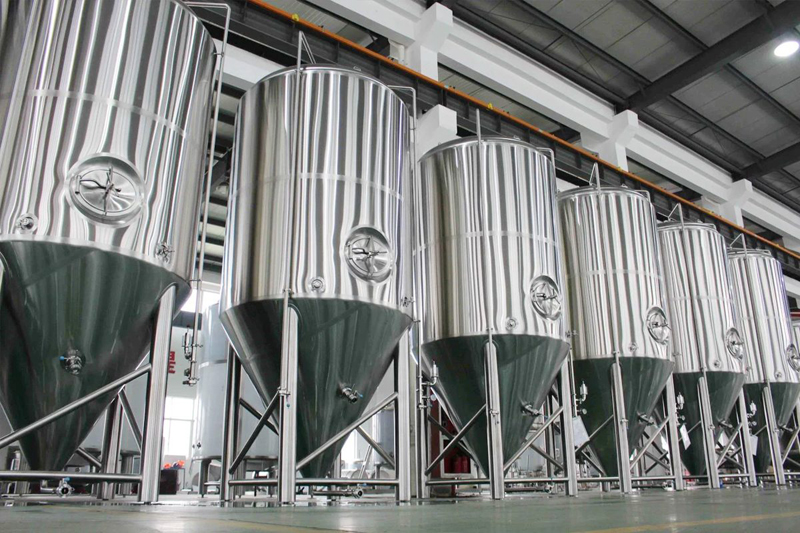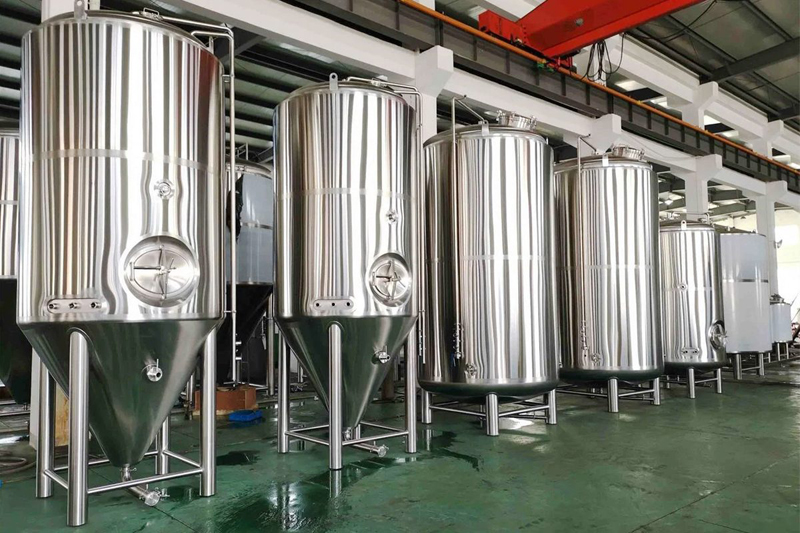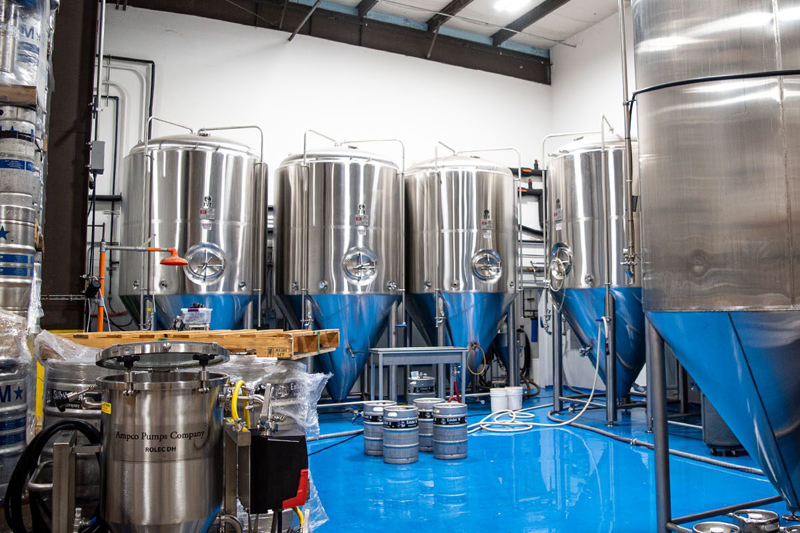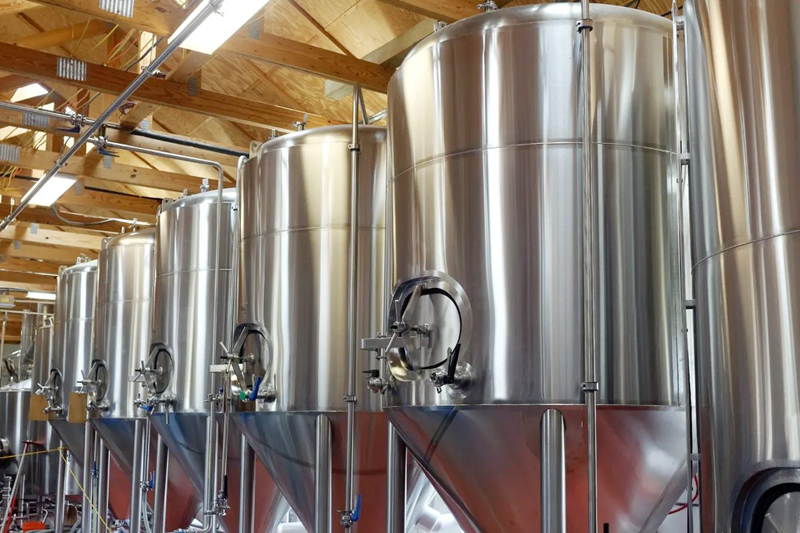How to Selecting A Right fermentation tanks
When selecting fermentation tanks for a brewery, it’s essential to consider several factors that can significantly impact the brewing process, product quality, and long-term production efficiency. The right tank will support optimal fermentation and provide scalability, ease of maintenance, and consistency in brewing different beer styles. From the material and design of the tank to its size, cooling system, and pressure management, each aspect plays a critical role in ensuring a smooth fermentation process. Whether you are a small craft brewery or a large-scale commercial operation, understanding these key considerations will help you make informed decisions that align with your production goals, budget, and growth potential. This article will explore the most important factors when selecting fermentation tanks to support your brewery’s success.
1.Tank design
2.Volume Considerations and Scalability
3.Cooling Jackets and Temperature Control
4.Cleaning and Sanitization Systems (CIP Systems)
1.Tank Design
Fermentation tank design can help optimize the brewing process, increase efficiency, and ensure consistent beer quality. Different tank designs serve specific brewing needs, and the right choice will depend on the style of beer being produced, the volume of production, and the brewery’s operational workflow.
Cylindroconical Tanks
Cylindroconical tanks are the most common design used in modern breweries. These tanks have a cylindrical body with a conical bottom, which makes them highly efficient for managing yeast and sediment.
1.Yeast Collection and Management: The conical bottom allows yeast to settle and be collected easily, which is especially useful for re-pitching yeast in future brews or separating it from the beer after fermentation.
2.Enhanced Fermentation Control: The shape of cylindroconical tanks promotes even distribution of temperature and pressure, leading to more consistent fermentation. They also support pressurized fermentation, which can help brew certain beer styles (like lagers).
3.Improved Cleaning: The smooth walls and angled bottom of these tanks make them easier to clean and sanitize, reducing contamination risks and ensuring high-quality output.
Horizontal Tanks
While cylindroconical tanks dominate the industry, horizontal tanks can also be used, particularly for specific beer styles such as lagers.
1.Flavor Profile: Horizontal tanks provide more surface area for yeast to interact with the wort, leading to a different fermentation profile. They are often used for lagering, where a longer maturation time at lower temperatures is required.
2.Space Considerations: Horizontal tanks can be useful for breweries with limited vertical space, as they take up more floor area but require less height.
Custom and Specialty Designs
Some breweries opt for custom-designed tanks to meet unique production needs or space constraints. These custom tanks are tailored to the specific brewing process or to fit into unusual spaces within a brewery.
1.Multi-Purpose Tanks: Some fermentation tanks are designed to serve dual purposes, such as fermenting and aging, allowing for a more streamlined process in breweries with limited equipment.
2.Unique Shapes and Features: Depending on the brewery’s goals, tanks can be designed with specialized features such as additional manways, sampling ports, or integrated systems for dry hopping or barrel aging.
Considerations for Small VS. Large Breweries
For smaller breweries or those focusing on experimental brews, flexibility in tank design is key. Small batches may benefit from tanks with adaptable designs, such as adjustable fermentation volumes or multiple ports for different brewing stages. On the other hand, larger breweries prioritize scalability and automation, often opting for standardized tanks that can be easily integrated into automated brewing systems.
Selecting the right tank design can help achieve the desired brewing results. Cylindroconical tanks provide versatility and efficiency for most beer styles, while horizontal tanks and custom designs offer specialized advantages for certain production methods. Understanding your brewery’s production goals and space limitations will help you choose the optimal design to ensure consistent, high-quality beer.
2.Volume Considerations and Scalability
Selecting the right fermentation tank capacity can help meet your current production needs and future growth. The size of the tank not only affects your brewery’s output capacity but also plays a role in operational efficiency and flexibility. Whether you’re a small craft brewery or a large commercial brewery, careful planning of fermentation tank capacity can help achieve scalability without sacrificing quality or workflow efficiency.
Small-Scale Breweries
For smaller breweries, such as craft operations or those just starting, fermentation tanks typically range from 100L to 1,000L. These smaller tanks are ideal for producing limited batches, allowing for greater flexibility in experimenting with new beer styles and recipes. Additionally, small-volume tanks enable brewers to fine-tune their fermentation processes without committing to large production runs. However, brewers should also plan for future expansion by considering tanks that offer the ability to scale up without needing a complete overhaul of their equipment.
Medium to Large Breweries
As production increases, so does the need for larger fermentation tanks. Medium and large breweries often use tanks ranging from 5,000L to 20,000L or more, depending on production requirements. The goal for these operations is to ensure that the tanks are large enough to handle higher production volumes while maintaining consistent fermentation conditions. Choosing larger tanks upfront can significantly reduce the number of batches required to meet production goals, increasing overall efficiency.
Batch Flexibility
One important factor to consider is how the volume of your fermentation tank aligns with your brewing schedule. Tanks that are too large can lead to overproduction, increased waste, or even underutilization, while tanks that are too small might cause frequent production delays or capacity limitations. Balancing tank volume with batch size ensures that your brewery can operate at maximum efficiency without straining resources.
Modular Expansion
Scalability is key when selecting fermentation tanks. Modular or stackable tank designs allow breweries to expand their capacity gradually without major structural changes. For growing breweries, investing in tanks that can be easily expanded or connected to other units enables flexibility and reduces long-term costs. Many brewers also opt for standardized tank sizes to streamline future expansions, making it easier to add tanks to their existing production lines.
Future-Proofing Your Brewery
Planning for future growth is crucial. When selecting tank volumes, think about where your brewery will be in 5 or 10 years. Over time, as demand for your beer grows, the ability to scale your production will prevent costly upgrades or the need to replace equipment prematurely. Investing in larger or more scalable fermentation tanks from the outset can save time and money down the road.
Selecting the right tank volume is a balance between current needs and future growth potential. Small breweries benefit from smaller, flexible tanks, while larger breweries require higher-volume tanks to maintain efficient production. Prioritizing scalability ensures that your brewery can expand its operations without costly disruptions, making volume considerations a key factor in long-term success.
3.Cooling Jackets and Temperature Control
One of the most critical aspects of the fermentation process is maintaining precise temperature control, as it directly influences yeast activity, fermentation speed, and ultimately, the quality of the beer. Cooling jackets play a vital role in helping brewers regulate the temperature within fermentation tanks, ensuring consistent and optimal conditions for yeast to thrive.
Importance of Temperature Control
Fermentation temperature significantly affects yeast behavior, impacting factors such as fermentation rate, alcohol production, and flavor development. Different beer styles require different fermentation temperatures. For example, ales typically ferment at warmer temperatures (around 18-22℃), while lagers require cooler temperatures (7-13℃). Proper temperature control prevents off-flavors and ensures that the yeast produces the desired flavor profile.
Cooling Jackets
Cooling jackets are built-in systems that circulate coolant—usually glycol or chilled water—through the tank to maintain the desired temperature. These jackets are typically placed around the sides of the fermentation tank and come in different configurations depending on the brewery’s needs.
1.Glycol Jackets: The most common type of cooling jacket uses glycol, a liquid coolant, to regulate the temperature inside the tank. Glycol is circulated through channels or dimpled jackets that wrap around the tank, pulling heat away from the fermenting beer. This system provides precise control and is highly efficient, especially for larger tanks.
2.Multiple Cooling Zones: Larger tanks may have multiple cooling zones, allowing different parts of the tank to be cooled independently. This is important for controlling the fermentation process more accurately, especially in tall cylindroconical tanks where temperature stratification can occur.
3.Energy Efficiency: A well-designed cooling jacket system minimizes energy consumption by maintaining stable temperatures, reducing the load on refrigeration units.
Insulation
In addition to a cooling jacket, proper insulation can maintain a consistent temperature within the fermentation tank. High-quality insulation prevents external heat from affecting the fermentation process, reducing energy consumption and improving efficiency.
1.Double-Walled Tanks: Most commercial fermentation tanks are double-walled with insulation between the walls. This helps maintain a stable internal environment while minimizing the influence of ambient temperatures.
2.Energy Savings: Well-insulated tanks not only ensure precise temperature control but also contribute to energy savings by reducing the workload on cooling systems.
Automated Temperature Control Systems
Many modern fermentation tanks are equipped with automated temperature control systems. These systems use temperature sensors placed inside the tank to continuously monitor the beer’s temperature and adjust the cooling system as needed. Automated controls provide several advantages:
1.Precision: Automated systems allow brewers to set specific temperature profiles for different stages of fermentation. This ensures that the tank maintains the correct temperature for optimal yeast activity.
2.Consistency: Automated systems help maintain consistent temperature conditions across multiple fermentation tanks, which is especially important in larger breweries where managing several batches simultaneously can be challenging.
3.Remote Monitoring: Some advanced temperature control systems offer remote monitoring, allowing brewers to track and adjust fermentation temperatures from anywhere, ensuring the process runs smoothly even when not physically present in the brewery.
Heat Exchange Efficiency
Efficient heat exchange can help maintain the desired fermentation temperature without overworking the cooling system. A well-designed cooling jacket system, combined with proper insulation, ensures that the tank can quickly and efficiently dissipate excess heat generated by yeast activity during fermentation.
Tailoring Temperature Control to Beer Styles
Different beer styles have unique fermentation temperature requirements. With precise control over the cooling jackets and temperature systems, brewers can create the ideal environment for various beer types:
1.Ales: Typically require warmer fermentation temperatures, which need to be maintained to allow for quicker yeast activity.
2.Lagers: Require cooler, longer fermentation periods. Cooling jackets are essential for maintaining the low temperatures necessary for lagering without fluctuations.
Cooling jackets and temperature control systems are essential components of fermentation tanks, directly influencing the quality and consistency of beer. Investing in a well-designed cooling system, combined with proper insulation and automated controls, ensures optimal fermentation conditions, energy efficiency, and the flexibility to brew a wide variety of beer styles.
4.Cleaning and Sanitization Systems (CIP Systems)
Cleanliness is one of the most critical aspects of brewing, as it directly impacts the quality, flavor, and safety of the beer. To maintain high standards of hygiene, fermentation tanks are often equipped with Clean-In-Place (CIP) systems. These automated systems allow for efficient and thorough cleaning without the need to disassemble the tank, ensuring that the brewing environment remains sanitary while saving time and labor.
What Is a CIP System?
A Clean-In-Place (CIP) system is a setup that enables the automated cleaning and sanitization of the fermentation tank’s interior surfaces without requiring manual intervention. CIP systems typically consist of spray balls, pumps, and chemical delivery systems that distribute cleaning solutions throughout the tank, removing residue, yeast, and potential contaminants from the previous brewing cycle.
Key Components of CIP Systems
Effective CIP systems are designed with several essential components that work together to ensure thorough cleaning and sanitization:
1.Spray Balls: Spray balls are installed inside the tank and connected to the cleaning solution delivery system. These nozzles spray high-pressure cleaning solutions onto all interior surfaces of the tank, ensuring that every part is cleaned evenly. Some systems use rotating spray balls to cover more surface area, improving the efficiency of the cleaning process.
2.Pumps: Pumps are used to circulate cleaning agents through the tank during the CIP process. Depending on the system, different chemicals—such as caustic solutions, sanitizers, and rinsing water—are cycled through the tank to remove organic materials and sanitize the interior.
3.Cleaning Solutions: Breweries use a combination of cleaning agents during the CIP process, including alkaline cleaners to remove organic deposits, acid cleaners to eliminate mineral buildup, and sanitizers to kill any remaining microorganisms. These solutions are selected based on the specific needs of the brewery and the materials used in the tank construction.
Benefits of CIP Systems
Implementing a CIP system provides several advantages for breweries, particularly in terms of operational efficiency and sanitation:
1.Time and Labor Savings: CIP systems automate the cleaning process, significantly reducing the time and labor required to clean and sanitize tanks manually. This is especially valuable in larger breweries where several tanks need to be cleaned regularly.
2.Consistent Cleaning: CIP systems ensure that every part of the tank is cleaned evenly, leaving no areas of potential contamination. This consistency helps maintain the quality and safety of each batch of beer.
3.Reduced Risk of Contamination: Manual cleaning processes can introduce contaminants into the tank, especially if workers need to enter the tank. With a CIP system, the cleaning process is completely closed, minimizing the risk of contamination from outside sources.
4.Improved Efficiency: CIP systems use optimized amounts of cleaning solutions, water, and energy, reducing waste and improving the overall efficiency of the cleaning process. This helps breweries reduce costs while maintaining high standards of sanitation.
Automation and Control Systems
Many modern CIP systems are fully automated, allowing brewers to set specific cleaning cycles for each tank. These automated systems can control the duration and temperature of each cleaning phase, ensuring that the cleaning process is optimized for the tank’s size and design. Additionally, automation allows brewers to monitor and adjust cleaning processes remotely, improving overall operational efficiency.
1.Customizable Cleaning Programs: Breweries can create tailored cleaning programs for different stages of the brewing process or different types of beer, ensuring that each tank receives the appropriate level of cleaning and sanitization.
2.Monitoring and Reporting: Advanced CIP systems provide real-time monitoring of cleaning parameters, including temperature, pressure, and chemical concentration, ensuring that cleaning is consistent and meets regulatory standards. This data can also be logged for quality assurance purposes.
Sanitation and Quality Assurance
An effective CIP system can maintain high-quality brewing standards and prevent contamination. By thoroughly cleaning the fermentation tanks, breweries can ensure that no residual yeast, bacteria, or organic material from previous batches affects the next production cycle. This helps maintain the flavor, aroma, and quality of the beer, while also reducing the risk of spoilage or off-flavors caused by unwanted microorganisms.
Compliance with Industry Standards
In addition to improving operational efficiency and product quality, well-designed CIP systems help breweries comply with industry hygiene standards, such as those set by the FDA or European brewing regulations. Using CIP systems ensures that cleaning processes are consistent, repeatable, and verifiable, making it easier for breweries to meet regulatory requirements.
Clean-in-place (CIP) systems are a crucial component of modern fermentation tanks, providing a reliable and efficient method of maintaining cleanliness and sanitation. By automating the cleaning process, breweries can reduce labor, minimize contamination risks, and ensure consistent quality in every batch of beer. Investing in a well-designed CIP system not only enhances operational efficiency but also ensures compliance with industry standards and supports long-term product quality.
Summary
Selecting the right fermentation tanks is crucial for ensuring the efficiency, quality, and scalability of your brewery. Key factors to consider include the material construction, with stainless steel being the most durable and sanitary choice, and the tank design, which must suit the specific beer styles you produce. Volume considerations should align with your current and future production needs, while features like cooling systems and pressure management ensure consistent fermentation. Additionally, specialized processes like sour beer production or high-gravity brewing may require unique tank configurations. Compliance with industry standards guarantees safety and operational efficiency, while aesthetics and branding can enhance the customer experience in public-facing spaces. Cost considerations, including both initial investment and operational costs, play a major role in decision-making, and partnering with a supplier that offers turnkey solutions and support ensures long-term success. By carefully evaluating these factors, you can select fermentation tanks that align with your production goals and business growth.
 Jinan Alston Equipment Co.,Ltd.
Jinan Alston Equipment Co.,Ltd.



